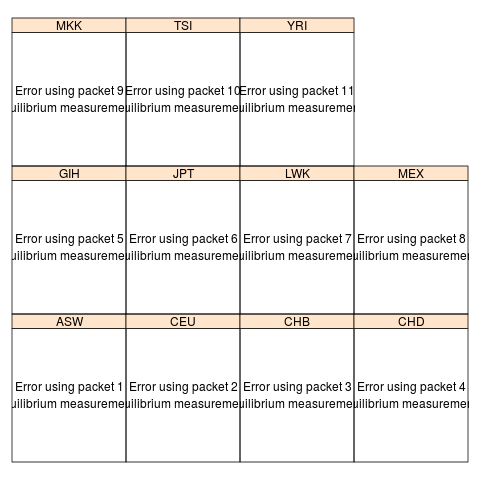Supported by Dr. Osamu Ogasawara and  providing providing  . . |
|
Last data update: 2014.03.03 |
Example data set for LDheatmapDescriptionSNP genotypes on HapMap founders for SNPs spanning the GIMAP5 gene. Usagedata(GIMAP5) FormatGIMAP5 is a list with three elements: snp.data, snp.support and
subject.support. snp.data is a
subject.support is a one-column data frame with:
DetailsSNP genotypes from HapMap release 27 for SNPs in a 10KB region spanning the GIMAP5 gene. Data are on founders from each of the 11 HapMap phase III populations:
Only those SNPs with minor allele frequency greater than 5% in all populations were retained. The base positions are from NCBI build 36 (UCSC genome hg18). SourceInternational HapMap Project www.hapmap.org ReferencesThe International HapMap Consortium. A haplotype map of the human genome. Nature 437, 1299-1320. 2005. See Also
Examples
data(GIMAP5)
#Now do a lattice plot with LDheatmaps in the panels
library(lattice)
pop<-GIMAP5$subject.support$pop
n<-nrow(GIMAP5$snp.data)
xyplot(1:n ~ 1:n | pop, type="n", scales=list(draw=FALSE), xlab="", ylab="",
panel=function(x, y, subscripts,...) {
LDheatmap(GIMAP5$snp.data[subscripts,],GIMAP5$snp.support$Position,
newpage=FALSE)})
rm(pop,n)
Results
R version 3.3.1 (2016-06-21) -- "Bug in Your Hair"
Copyright (C) 2016 The R Foundation for Statistical Computing
Platform: x86_64-pc-linux-gnu (64-bit)
R is free software and comes with ABSOLUTELY NO WARRANTY.
You are welcome to redistribute it under certain conditions.
Type 'license()' or 'licence()' for distribution details.
R is a collaborative project with many contributors.
Type 'contributors()' for more information and
'citation()' on how to cite R or R packages in publications.
Type 'demo()' for some demos, 'help()' for on-line help, or
'help.start()' for an HTML browser interface to help.
Type 'q()' to quit R.
> library(LDheatmap)
Loading required package: grid
> png(filename="/home/ddbj/snapshot/RGM3/R_CC/result/LDheatmap/GIMAP5.Rd_%03d_medium.png", width=480, height=480)
> ### Name: GIMAP5
> ### Title: Example data set for LDheatmap
> ### Aliases: GIMAP5
> ### Keywords: datasets
>
> ### ** Examples
>
> data(GIMAP5)
> #Now do a lattice plot with LDheatmaps in the panels
> library(lattice)
> pop<-GIMAP5$subject.support$pop
> n<-nrow(GIMAP5$snp.data)
> xyplot(1:n ~ 1:n | pop, type="n", scales=list(draw=FALSE), xlab="", ylab="",
+ panel=function(x, y, subscripts,...) {
+ LDheatmap(GIMAP5$snp.data[subscripts,],GIMAP5$snp.support$Position,
+ newpage=FALSE)})
> rm(pop,n)
>
>
>
>
>
> dev.off()
null device
1
>
|
